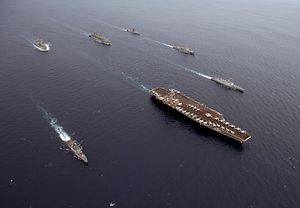My previous column worked through some implications of the CSIS model for the future development of the U.S. Navy. Without doubt, the model generates some interesting discussion points for how different fleets, potentially with different strategic rationales, might look.
However, as with any projection, it’s useful to ask where long-range expectations could go wrong. The CSIS model projects linear ship development, based on a few archetypal classes; large surface combatants, small surface combatants, and so forth. This raises the question of how effectively we can make long-term predictions about the general contours of ship types. A projection of 2017, based on 1987, would do rather well; today’s fleet is constituted mainly from platforms in development in the Reagan administration. The exceptions (the Littoral Combat Ship, for example) fortunately fit nicely into established categories, even if the meaning has changed (an LCS is a small surface combatant, but performs a far different function than the Oliver Hazard Perry-class frigates of 1987).
But from the 1970s on, the U.S. Navy has considered a variety of alternative ship types that would break the model. In particular, the USN has repeatedly returned to the idea of a large surface combatant, without ever being able to pull the trigger. In the mid-1970s the USN investigated the “Strike Cruiser,” an 18,000 ton nuclear-powered ship that would have included extensive anti-surface weaponry in addition to self- and area-defense systems such as Aegis.
The return of the Iowa-class battleships helped scotch the Strike Cruiser concept, but the idea of a large surface combatant kept coming back. Equipped with a 512-cell Vertical Launch System, the “Arsenal Ship” of the 1990s would have deployed off the coast of a prospective target, then saturated the unfortunate victim with wave after wave of Tomahawks. The largest version of the proposed ship would have displaced around 30,000 tons, and included some self-defense systems.
The Navy took a different tack with the CGX. Foreseeing a need to replace the Ticonderoga-class cruisers in the not-too-distant future, the Navy envisioned a ship that would displace around 25,000 tons, equipped with many of the features that eventually ended up in the Zumwalt-class destroyer. Compared with the Zumwalt, the CGX would have had enhanced air defense systems, ballistic missile defense capability, and a nuclear propulsion system to generate all of the necessary power. But in the end, the Navy couldn’t force Congress to cough up enough money to buy an adequate number of Zumwalts, much less the CGX.
Predictions are hard, especially about the future. The CSIS tool doesn’t even accommodate the Zumwalts, much less the large ships discussed here. But given how often the Navy has repeatedly returned to the large surface ship concept, and how some technological threads seem to be coming together that would enable the success of such a platform, it might be worth it for CSIS to add a button for experimental combat vessels.

































